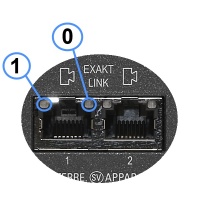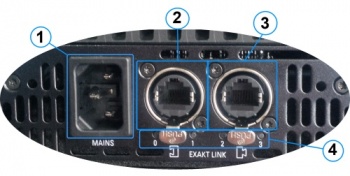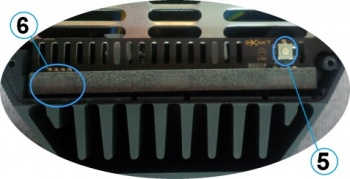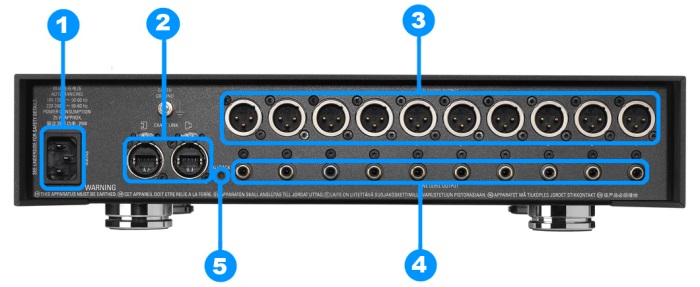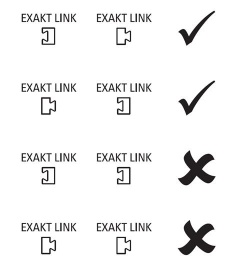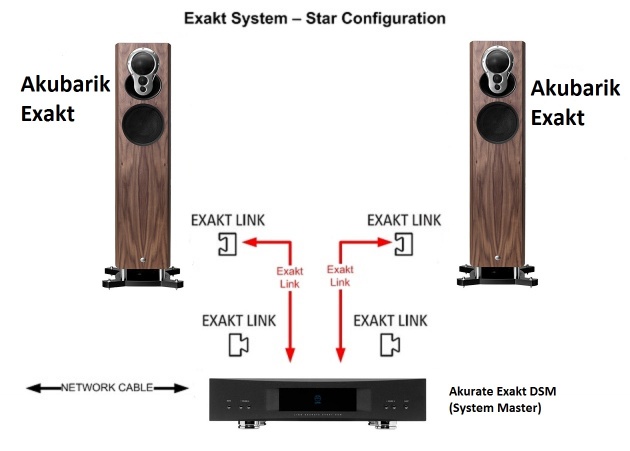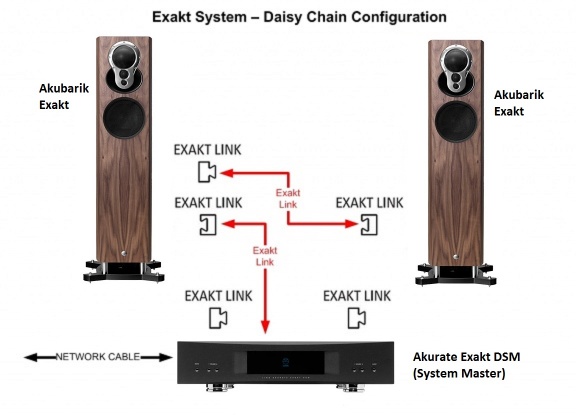Difference between revisions of "Akurate Exakt System"
(Created page with "== SYSTEM INFORMATION == * ''Product Name:'' AKURATE EXAKT DSM & EXAKT AKUBARIK * ''Date of Introduction:'' APRIL 2014 * ''Features'' EXAKT TECHNOLOGY <BR> <BR> == AKURATE E…") |
m (→AKURATE EXAKTBOX) |
||
| (27 intermediate revisions by 2 users not shown) | |||
| Line 10: | Line 10: | ||
<BR> | <BR> | ||
| − | == AKURATE EXAKT DSM == | + | ==[[Akurate_Exakt_DSM_(4K_compatible)| AKURATE EXAKT DSM/1 ]]== |
| + | The Akurate Exakt system has NO headphone socket on the front panel. If you wish to use headphones we would suggest using a headphone amplifier that can take either Toslink or SPDIF from the Akurate Exakt DSM Toslink/SPDIF outputs. | ||
=== Back Panel === | === Back Panel === | ||
| + | {{Backpanel:Akurate_Exakt_DSM/1}} | ||
| − | + | == [[Akurate_DSM_(Katalyst)| AKURATE DSM/3 (Mk3)]] == | |
| − | [[ | + | === '''Back Panel Connections''' === |
| + | {{Backpanel:Akurate DSM/3}} | ||
| − | + | == [[Akubarik_Exakt | '''EXAKT AKUBARIK''']] == | |
| − | |||
| − | |||
| − | |||
| − | |||
| − | |||
| − | |||
| − | |||
| − | |||
| − | |||
| − | |||
| − | |||
| − | |||
| − | |||
| − | |||
| − | |||
| − | |||
| − | |||
| − | |||
| − | |||
| − | |||
| − | |||
| − | |||
| − | |||
| − | |||
| − | |||
| − | |||
| − | |||
| − | |||
| − | |||
| − | |||
| − | |||
| − | |||
| − | |||
| − | |||
| − | |||
| − | |||
| − | |||
| − | |||
| − | |||
| − | |||
| − | |||
| − | |||
| − | |||
| − | |||
| − | |||
| − | |||
| − | |||
| − | |||
| − | |||
| − | |||
| − | |||
| − | |||
| − | |||
| − | |||
| − | |||
| − | |||
| − | |||
| + | === Lower Back Panel === | ||
| + | [[Image:Marked_Bottom_conns.jpg|right|350x700px|Image:Akubarik Exakt]] <br> | ||
# '''MAINS INPUT''' - To connect to the mains electricity supply. | # '''MAINS INPUT''' - To connect to the mains electricity supply. | ||
| − | |||
| − | |||
# '''EXAKT LINK''' - From Exakt Master OR from a Exakt Slave connected to the Exakt master | # '''EXAKT LINK''' - From Exakt Master OR from a Exakt Slave connected to the Exakt master | ||
# '''EXAKT LINK''' - To Exakt Slave product | # '''EXAKT LINK''' - To Exakt Slave product | ||
| − | # '''STATUS INDICATORS''' - Function of the LED's are given below: | + | # '''EXAKT STATUS INDICATORS''' - Function of the LED's are given below: |
| − | + | ||
| − | === LED Status === | + | === EXAKT LED Status === |
{| border="1" cellspacing="0" cellpadding="0" width="55%" align="LEFT" | {| border="1" cellspacing="0" cellpadding="0" width="55%" align="LEFT" | ||
| Line 128: | Line 74: | ||
|} | |} | ||
| − | <BR><BR><BR><BR><BR><BR><BR><BR><BR> | + | <BR><BR><BR><BR><BR><BR><BR><BR><BR><BR> |
| − | <BR><BR><BR><BR><BR> | + | <BR><BR><BR><BR> |
| − | |||
| − | |||
| − | |||
| − | |||
| − | |||
| − | === Back Panel === | + | === Upper Back Panel === |
| + | [[Image:AkurBarik Top plate1.jpg|right|350x700px|Image:Akubarik Exakt]] <br> | ||
| − | + | 5 '''FALLBACK''' - To put the device into Fallback mode (used when reprogramming the unit).<br> | |
| + | 6 '''SPEAKER STATUS INDICATORS''' - Combined RED/Blue LEDs showing the speaker function. See below: <br> | ||
| − | |||
| − | |||
| − | |||
| − | |||
| − | |||
| − | |||
| − | |||
| − | === LED | + | === Speaker status LED === |
| − | |||
| − | |||
{| border="1" cellspacing="0" cellpadding="0" width="65%" align="LEFT" | {| border="1" cellspacing="0" cellpadding="0" width="65%" align="LEFT" | ||
|- | |- | ||
| − | | bgcolor="#cccccc" width=" | + | | bgcolor="#cccccc" width="30%" align="center" | |
| − | '''''LED''''' | + | '''''RED LED''''' |
| − | | bgcolor="#cccccc" width=" | + | | bgcolor="#cccccc" width="30%" align="center" | |
| − | ''''' | + | '''''BLUE LED''''' |
| − | | bgcolor="#cccccc" width=" | + | | bgcolor="#cccccc" width="40%" align="center" | |
| − | ''''' | + | '''''STATUS''''' |
| − | |||
| − | |||
|- | |- | ||
| − | | align="center" | ''' | + | | align="center" | '''OFF''' |
| − | | align="center" | | + | | align="center" | '''OFF''' |
| − | |||
| − | |||
| − | |||
| − | |||
| − | |||
| − | |||
| − | |||
| − | |||
| − | |||
| − | |||
| − | |||
| − | |||
| − | |||
| − | |||
| − | |||
| − | |||
| − | |||
| − | |||
| − | |||
| − | |||
| − | |||
| − | |||
| − | |||
| − | |||
| − | |||
| − | |||
| − | |||
| − | |||
| − | |||
| − | |||
| − | |||
| − | |||
| − | |||
| − | |||
| − | |||
| − | |||
| − | |||
| − | |||
| − | |||
| − | |||
| − | |||
| − | |||
| − | |||
| − | |||
| − | |||
| − | ''''' | ||
| − | |||
| − | |||
| − | |||
| − | |||
| − | |||
| − | |||
| − | |||
| − | |||
| − | |||
| − | |||
| align="center" | No Power | | align="center" | No Power | ||
|- | |- | ||
| − | | align="center" | | + | | align="center" | '''OFF''' |
| − | | align="center" | | + | | align="center" | '''ON''' |
| − | | align="center" | Active | + | | align="center" | Active |
| − | |||
|- | |- | ||
| − | |||
| − | |||
| − | |||
| + | | align="center" | '''ON''' | ||
| + | | align="center" | '''OFF''' | ||
| + | | align="center" | Standby (Not implemented) | ||
|- | |- | ||
| − | |||
| − | |||
| − | |||
| + | | align="center" | '''ON''' | ||
| + | | align="center" | '''ON''' | ||
| + | | align="center" | Invalid state | ||
|- | |- | ||
| − | | align="center" | | + | | align="center" | '''OFF''' |
| − | | align="center" | Slow | + | | align="center" | '''Slow flash''' |
| align="center" | Discovering | | align="center" | Discovering | ||
| − | |||
|- | |- | ||
| − | | align="center" | | + | | align="center" | '''OFF''' |
| − | | align="center" | Fast | + | | align="center" | '''Fast flash''' |
| align="center" | Configuring | | align="center" | Configuring | ||
| − | |||
|- | |- | ||
| − | | align="center" | Fast | + | | align="center" | '''Fast flash''' |
| − | | align="center" | | + | | align="center" | '''OFF''' |
| − | | align="center" | Hardware | + | | align="center" | Hardware fault |
| − | |||
|- | |- | ||
| − | | align="center" | Slow Alternating | + | | align="center" | '''Slow Alternating flash''' |
| − | | align="center" | Slow Alternating | + | | align="center" | '''Slow Alternating flash''' |
| − | | align="center" | Fallback | + | | align="center" | Fallback mode |
| − | |||
|- | |- | ||
| − | | align="center" | Fast Alternating | + | | align="center" | '''Fast Alternating flash''' |
| − | | align="center" | Fast Alternating | + | | align="center" | '''Fast Alternating flash''' |
| align="center" | Reflashing | | align="center" | Reflashing | ||
|} | |} | ||
| + | <BR><BR><BR><BR><BR><BR><BR><BR><BR><BR><BR> | ||
<BR> | <BR> | ||
| − | <BR> | + | <BR><BR><BR><BR> |
| − | <BR> | + | |
| + | == [[Akurate_ExaktBox_6-10/0_(2014_variant) | '''AKURATE EXAKTBOX''']] == | ||
| + | |||
| + | [[Image:Ak_ExaktBox_BP-Nums.jpg|center|700px]] | ||
| − | + | # '''MAINS INPUT''' - To connect to the mains electricity supply. | |
| + | # '''EXAKT LINK'''- To connect to Exakt compatible devices (CAT-5 cables) | ||
| + | # '''ANALOGUE OUTPUTS''' (XLR,variable level) - To connect to power amplifiers with balanced (XLR) analogue inputs. (300ohm Output impedance) | ||
| + | # '''ANALOGUE OUTPUTS''' (RCA, variable level) - To connect to power amplifier with unbalanced (RCA) analogue inputs. (300ohm Output impedance) | ||
| + | # '''FALLBACK''' - To put the device into Fallback mode (used when reprogramming the unit). | ||
| + | Note: Both XLR and RCA outputs are active simulatneously. | ||
== EXAKT LINK Connections == | == EXAKT LINK Connections == | ||
| Line 288: | Line 168: | ||
=== Configurations === | === Configurations === | ||
| + | |||
| + | |||
Exakt Systems can be configured either a star from the system master or as a daisy chain configuration. Examples of each configuration is shown below. | Exakt Systems can be configured either a star from the system master or as a daisy chain configuration. Examples of each configuration is shown below. | ||
| − | [[Image: | + | [[Image:Star_config_Akurate.jpg|centre|630x451px|Star Configuration]] <br> |
| − | [[Image: | + | [[Image:Daisy_chain_Config_Akubarik.jpg|centre|630x415px|Daisy Chain Configuration]] <br> |
Note: There is no change in audio performance between the star configuration or the daisy chain configuration. | Note: There is no change in audio performance between the star configuration or the daisy chain configuration. | ||
== EXAKT Setup and Optimisation == | == EXAKT Setup and Optimisation == | ||
| − | |||
| − | + | One of the beneifts of the Exakt system is that you can easily setup and optimise your listening environment. Simply [http://www.linn.co.uk/software download] the latest version of Konfig (version 4.11.7 or higher) and follow the [[Space_Optimsation|Space_Optimsation+]] & [[Advanced_Space_optimisation | Space Optimisation (Advanced)]] | |
| − | [[ | ||
| − | |||
| − | + | == EXAKT Trouble shooting == | |
| − | == EXAKT | ||
| − | |||
| − | |||
| − | |||
[[ExaKt Trouble shooting|Click here for more info on Exakt Trouble shooting]] | [[ExaKt Trouble shooting|Click here for more info on Exakt Trouble shooting]] | ||
Latest revision as of 13:42, 5 October 2021
Contents
SYSTEM INFORMATION
- Product Name: AKURATE EXAKT DSM & EXAKT AKUBARIK
- Date of Introduction: APRIL 2014
- Features EXAKT TECHNOLOGY
AKURATE EXAKT DSM/1
The Akurate Exakt system has NO headphone socket on the front panel. If you wish to use headphones we would suggest using a headphone amplifier that can take either Toslink or SPDIF from the Akurate Exakt DSM Toslink/SPDIF outputs.
Back Panel
- MAINS INPUT - To connect to the mains electricity supply.
- FALLBACK - To put the device into Fallback mode (used when reprogramming)
- ETHERNET - To connect to a network (100Base-T)
- EXAKT LINK - To connect to Exakt compatible devices (Exaktbox, Exakt Speakers, Urika II etc)
- ANALOGUE INPUT 1 (XLR, line level) - To connect sources with balanced (XLR) outputs.
- ANALOGUE INPUTS 2&3 (RCA, phono/line level) - To connect a turntable or line level3source with unbalanced (RCA) outputs1. (Default MC phono)
- PHONO GROUND - To connect to a turntable grounding terminal.
- ANALOGUE OUTPUTS - Not available
- ANALOGUE OUTPUTS - Not available
- DIGITAL INPUTS (Spdif) - To connect sources with Spdif (RCA) digital outputs.
- DIGITAL OUTPUT (Spdif) - To connect to an external DAC or computer that has an Spdif digital input.
- DIGITAL INPUTS (Toslink) - To connect sources with Toslink (optical) digital outputs.
- DIGITAL OUTPUT (Toslink) - To connect to an external DAC or computer that has a Toslink (optical) digital input.
- HDMI INPUTS - To connect sources with 1.4 & 2.02 HDMI outputs.
- HDMI OUTPUT - To connect to a display device with 1.4 & 2.02 HDMI inputs.
- EARTH GROUND - To connect to an earthing terminal if no mains earth is available or to join to the earths of other products in the system to improve performance in areas of poor/noisy electrical earth conditions.
1 Input 3 is a configurable input, which is factory set as a moving coil phono input for connection to turntables. This can be changed by a Linn dealer to a moving magnet phono input or a line-level input.
2 Supports HDCP 2.2 up to and including 60Hz UHD. ![]() Linn recommend using Premium High Speed Certifiied HDMI cables for an optimal experience.
Linn recommend using Premium High Speed Certifiied HDMI cables for an optimal experience.
3 Input 3 can be adjusted for different Phono stages or Line level by reconfiguring a circuit board within the Linn DS.
LED Status
Each of the Exakt Link ports have two status LED's. The function of these LED's is given below:
|
LED |
OFF |
ON |
Flash / Blink |
| LED0 | Link Port Disabled | Link Port Enabled | n/a |
| LED1 | No Link | Product Discovered | Activity |
AKURATE DSM/3 (Mk3)
Back Panel Connections

- MAINS INPUT - To connect to the mains electricity supply.
- FALLBACK - To put the device into Fallback mode (used when reprogramming)
- ETHERNET - To connect to a network (100Base-T)
- EXAKT LINK - To connect to Exakt compatible devices (Exaktbox, Exakt Speakers, Urika II etc)
- ANALOGUE INPUTS (XLR, line level) - To connect an analogue source with balanced (XLR) outputs.
- ANALOGUE INPUTS (RCA, line level / phono) - To connect a line level or turntable analogue source with unbalanced (RCA) outputs.1
- PHONO GROUND - To connect to a turntable grounding terminal.
- ANALOGUE OUTPUTS (XLR,variable level) - To connect to a preamplifier (or power amplifier when internal volume control is enabled) with balanced (XLR) analogue inputs.
- ANALOGUE OUTPUTS (RCA, variable level) - To connect to a preamplifier (or power amplifier when internal volume control is enabled) with unbalanced (RCA) analogue inputs.
- DIGITAL INPUTS (Spdif) - To connect sources with Spdif (RCA) digital outputs.
- DIGITAL OUTPUT (Spdif) - To connect to an external DAC or computer that has an Spdif digital input.
- DIGITAL INPUTS (Toslink) - To connect sources with Toslink (optical) digital outputs.
- DIGITAL OUTPUT (Toslink) - To connect to an external DAC or computer that has a Toslink (optical) digital input.
- HDMI INPUTS - To connect sources with HDMI outputs 2
- HDMI OUTPUT - To connect to a display device with HDMI inputs 2 and HDMI-ARC
- EARTH GROUND - To connect to an earthing terminal if no mains earth is available or to join to the earths of other products in the system to improve performance in areas of poor/noisy electrical earth conditions.
1 Input 2 is line level only. Input 3/PH is a configurable input, which is factory set as a moving coil phono input for connection to turntables. This can be changed by a Linn dealer to a moving magnet phono input or a line level input.
2 ![]() Linn recommend using Premium High Speed Certifiied HDMI cables for an optimal experience. (supporting HDCP 2.2 up to and including 60Hz UHD.)
Linn recommend using Premium High Speed Certifiied HDMI cables for an optimal experience. (supporting HDCP 2.2 up to and including 60Hz UHD.)
EXAKT AKUBARIK
Lower Back Panel
- MAINS INPUT - To connect to the mains electricity supply.
- EXAKT LINK - From Exakt Master OR from a Exakt Slave connected to the Exakt master
- EXAKT LINK - To Exakt Slave product
- EXAKT STATUS INDICATORS - Function of the LED's are given below:
EXAKT LED Status
|
LED |
OFF |
ON |
Flash / Blink |
| 0 Master Port | No Link | Link Discovered | Link Activity |
| 1 Audio Clock | No Clock | Clock locked | Clock not locked |
| 2 Slave Port | No Link | Link Enabled | Link Activity |
| 3 Software Status | Not Configured | Running | Hardware Fault |
Upper Back Panel
5 FALLBACK - To put the device into Fallback mode (used when reprogramming the unit).
6 SPEAKER STATUS INDICATORS - Combined RED/Blue LEDs showing the speaker function. See below:
Speaker status LED
|
RED LED |
BLUE LED |
STATUS
|
| OFF | OFF | No Power |
| OFF | ON | Active |
| ON | OFF | Standby (Not implemented) |
| ON | ON | Invalid state |
| OFF | Slow flash | Discovering |
| OFF | Fast flash | Configuring |
| Fast flash | OFF | Hardware fault |
| Slow Alternating flash | Slow Alternating flash | Fallback mode |
| Fast Alternating flash | Fast Alternating flash | Reflashing |
AKURATE EXAKTBOX
- MAINS INPUT - To connect to the mains electricity supply.
- EXAKT LINK- To connect to Exakt compatible devices (CAT-5 cables)
- ANALOGUE OUTPUTS (XLR,variable level) - To connect to power amplifiers with balanced (XLR) analogue inputs. (300ohm Output impedance)
- ANALOGUE OUTPUTS (RCA, variable level) - To connect to power amplifier with unbalanced (RCA) analogue inputs. (300ohm Output impedance)
- FALLBACK - To put the device into Fallback mode (used when reprogramming the unit).
Note: Both XLR and RCA outputs are active simulatneously.
EXAKT LINK Connections
Cables
Exakt Link uses readily available network cables:
- CAT 5 UTP/FTP
- CAT 6 UTP/FTP
Note: There is no change in the audio performance of the Exakt Link between Cat 5 or Cat 6 Cables.
Configurations
Exakt Systems can be configured either a star from the system master or as a daisy chain configuration. Examples of each configuration is shown below.
Note: There is no change in audio performance between the star configuration or the daisy chain configuration.
EXAKT Setup and Optimisation
One of the beneifts of the Exakt system is that you can easily setup and optimise your listening environment. Simply download the latest version of Konfig (version 4.11.7 or higher) and follow the Space_Optimsation+ & Space Optimisation (Advanced)

